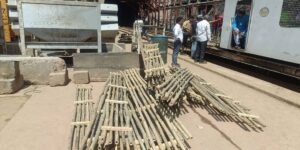Mounting slush inside the tunnel has been hampering the search and rescue operation.
Published Feb 24, 2025 | 5:16 PM ⚊ Updated Feb 24, 2025 | 5:16 PM

Entrance of SLBC tunnel
Synopsis: Mounting slush has slowed down the search and rescue operation. Rat miners, the heroes who rescued 41 trapped workers in Uttarakhand in 2023, too, have reached the scene.
Three checkposts have come up along the steep final five kilometers to the Srisailam Left Bank Canal (SLBC) Tunnel at Domapenta in Telangana’s Nagarkurnool district, where eight workers, including two engineers, are trapped in the debris for over 50 hours.
The men were trapped when the upper portion of a part of the 44-kilometer tunnel collapsed at the 14-kilometer point around 8.30 am on Saturday, 22 February.
On Monday, 24 February, faces outside the tunnel’s entrance looked grim as rescue teams hurried to reach the workers trapped in about 10 feet of increasing slush.
NDRF, SDRF, Army, Navy, and a team of rat miners, too, are at the scene, besides police, fire and health department officials, and local fishermen.
Fifteen ambulances from the government-private Dial 108 partnership were parked outside along with two health department vehicles with post-mortem kits.
A group of political workers have gathered at the first checkpost, adding to the already tense situation. The members of the public were stopped at the first checkpoint, and those who managed to dodge the police were sent back as they reached the second barrier.
Further entry has been restricted to NDRF, SDRF, police, fire, and health department personnel, other rescue workers, and the media.
A health worker, who is part of the ambulance fleet, looked both impatient and worried. “We have been waiting here since Saturday, ever since the incident occurred. We are just waiting for the workers to come out. It’s been more than 50 hours since they got trapped… tell me, who do you think will make it,” he asked a question that has now begun bothering everyone at the scene.
Despite a pall of gloom blanketing the scene, rescue workers raced against time relentlessly, burrowing, removing the slush, coordinating — and again digging — through the 10-ft slush that had accumulated in the tunnel — and rising almost to the roof — after the collapse. Hope — albeit clouded with doubt — has been pushing them forward.
Of the eight trapped people, four hailed from Jharkhand. They have been identified as Manoj Kumar (Project Engineer – Uttar Pradesh); Srinivas (Field Engineer – Uttar Pradesh); Sandeep Sahu (Worker – Jharkhand); Jatax (Worker – Jharkhand); Santosh Sahu (Worker – Jharkhand); Anuj Sahu (Worker – Jharkhand); Sunny Singh (Worker – Jammu & Kashmir); and Gurpreet Singh (Worker – Punjab).
Even as those involved in the rescue operation worked tirelessly and the country prayed for the safe return of the trapped men, a photograph was circulated on social media on Sunday, 24 February.
The picture showed a hand, prompting officials to clarify that it was not from the scene of the accident.
No bodies or evidence of trapped workers have been found, the officials said. On Sunday, rescue workers had tried calling the names of the trapped men, hoping for at least a faint response. None came.
“This photograph is false because we haven’t found anything,” an official involved in the rescue operation told South First.
“The image circulating online—if it was taken inside the tunnel—was likely clicked by a worker just after the incident. But the reality is completely different. The tunnel is filled with silt, making visibility almost impossible,” he said.
“The first team that managed to reach the end could at least stand on the conveyor belt, with about five-foot space separating the belt and roof. Now, that gap has shrunk to just two to two-and-a-half feet,” his words were not encouraging.
Officials further explained that since the accident, three rescue teams entered the tunnel, only to find conditions worsening each time.
“After covering 11 kilometers, they have to trudge another two-and-a-half kilometers. Earlier, they could walk on the conveyor belt, which is about 10 feet above the ground. But as they approach the tunnel boring machine, the gap between the roof and the conveyor belt narrows significantly,” the official added.
Additionally, the continuous flow of silt has created a downward slope spanning over two kilometers. Meanwhile, the water level inside the tunnel is gradually receding, offering a small window of hope in an otherwise bleak situation.
As time slips away, officials have turned to unconventional rescue methods, exploring every possible way to navigate the treacherous conditions inside the tunnel. They have used materials like tires, bamboo, and thermocol while constantly seeking new solutions.
“When we got a message from rescuers inside requesting tires, we arranged them within an hour,” another official told South First. “The team wanted to use them to move beyond the conveyor belt, where the Tunnel Boring Machine (TBM) parts begin.”
The search teams were using the conveyor belt to remove silt and rocks from inside the tunnel — until it snapped.

A hanging bridge made of bamboo pallets being loaded on the loco train for the rescue mission
When rescuers asked for thermocol pontoons, they were arranged within hours. Local fishermen from nearby villages were also called in to assist.
“The plan was to use the pontoons to navigate the slush without sinking, allowing rescuers to reach the collapsed section,” the official explained.
At one point, rescuers used long bamboo poles in the slush, hoping to detect any signs of the trapped workers.
The Navy was called in to assess whether divers could go into the slush and search for bodies.
“But it was impossible due to the density of the slush,” the official said. “It’s nearly 70% sand and the rest water, making the search difficult.”
Experts also warned against completely draining the water from the tunnel. “Water is continuously seeping in, and if we drain it entirely, the drop in pressure and oxygen levels could harden the slush. That would make it even harder to carry out the rescue or retrieve any bodies,” the official added.
In a bid to explore every possible option, the authorities have now called in the rat miners—the heroes of Operation Zindagi that rescued all 41 workers trapped in the Silkyara Bend–Barkot tunnel collapse in Uttarkashi, Uttarakhand in November 2023.

Rat Miners Team
“I saw the news about the incident at 2 am on Sunday,” Munna Quereshi, one of the rat miners, told South First.
“By evening, the district Collector asked us to take the next available flight. We reached Hyderabad late at night, and we reached here by morning.”
Quereshi has arrived with five team members, while six more are on their way.
“But before they arrive, we are going inside to assess the situation and see what can be done, as the situation here is different than it was in Uttarakhand. Waterflow is unabated here,” he added.
Meanwhile, a temporary suspension bridge made of bamboo pallets and ropes was constructed to provide better access inside the tunnel.
Above ground, medical teams from the Army Medical Corps, along with ambulances, remained on high alert, ready to provide immediate medical assistance to any survivors.
As the wait for a breakthrough continues, hope lingers despite the harsh reality that the rescue operation is becoming more complex with each passing hour.
(Edited by Majnu Babu).
